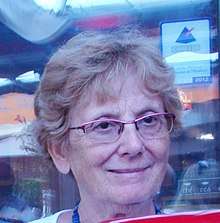Cécile Mourer-Chauviré
Cécile Mourer-Chauviré (born 5 November 1939) is a French paleontologist specializing in birds of the Eocene and the Oligocene.[1] In her early career, she discovered with her husband the Laang Spean cave site of prehistoric humans in Cambodia.[2][3]
Cécile Mourer-Chauviré | |
|---|---|
 Cécile Mourer-Chauviré | |
| Born | 5 November 1939[1] |
| Nationality | French |
| Scientific career | |
| Fields | Avian palaeontology |
Life and work
She studied at University of Lyon.[1] Her early work was on large Quaternary mammals.[1] She then proceeded in 1961 to a doctorate in Centre national de la recherche scientifique focusing on Pleistocene birds, a topic few at the time studied in France or Europe.[1]
Following her marriage in 1964 to Roland Mourer, she relocated to Cambodia where he was assigned by the French military as a "coopérant" in Kampong Chhnang (city).[1] In 1965 she was appointed as a geology professor at Royal University of Phnom Penh, a post she held until the civil war in 1970.[1] During this time she discovered with her husband the Laang Spean cave site of prehistoric humans.[2][3]
In 1970, at the outbreak of civil war in Cambodia, she returned with her two small children to France. In 1971, she secured an appointment with CNRS at Claude Bernard University Lyon 1.[1] In 1975 she completed her "Thèse d’Etat", in 1984 her habilitation, and in 1985 she was appointed director of research in CNRS which she held until her retirement in 2005.[1]
Since her return to France, and also following her retirement, she focused on research of avian fossils.[1] Between 1987 and 1999 she was secretary of the Society for Avian Paleontology and Evolution (SAPE).[1]
Recognition
The 8th international meeting of SAPE, in 2012, was dedicated to Mourer-Chauviré in tribute to her role as founder and secretary.[1]